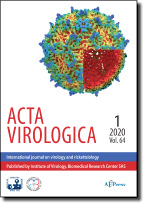Acta Virologica Vol.65, No.1, p.89-96, 2021
|
| Title: Multilocus sequence analysis of Candidatus Phytoplasma aurantifolia associated with phyllody disease of gerbera from India |
| Author: Kannappanahalli Venkatareddy Ashwathappa, Venkataravanappa Venkataravanappa, Lakshminarayana Reddy Cheegatagere Narasimha Reddy, Krishna Reddy Manem |
|
Abstract: Gerbera is the most popular cut flower known for its variety of colors and is grown across the world. Its production is challenged by numerous diseases affecting production and quality. During our survey, ten samples from the gerbera plants exhibiting phyllody disease symptoms were collected from Bangalore Rural District, Karnataka, India. The association of phytoplasma with the gerbera phyllody samples was confirmed by PCR using 16SrRNA, SecY, Ribosomal protein (rp) and SecA gene-specific primers. PCR products were amplified from all ten gerbera plants using phytoplasma-specific primers. The amplified PCR products were cloned and sequenced; the sequences of the ten clones were identical. Therefore, representative isolate (GePP1, Gerbera phyllody phytoplasma) was selected for further analysis. The sequence analysis showed that GePP1 shared maximum nucleotide (nt) identity of 97.1% (16SrRNA) with Eggplant big bud, 98.7 to 98.8% (SecY gene) with Tomato big bud, 99.2 to 99.6% (rp gene) with Alfalfa witches-broom (EF193371) and 99.1% (SecA gene) with Sesame phyllody phytoplasmas and that it belongs to the Ca. P. aurantifolia (16SrII) group. This result was well supported by the phylogenetic analysis showing GePP1 (16Sr RNA, SecY, rp and SecA genes) closely clustering with the Ca. P. aurantifolia 16SrII group isolates reported so far. The virtual RFLP pattern generated for the phytoplasma from gerbera was different (similarity coefficient 0.89) from the reference pattern of Ca. P. aurantifolia (16Sr II) subgroup after analysis with four enzymes (BfaI, Hha1, Sau3AI and RsaI). Based on the threshold similarity coefficient for a new subgroup (delineation should be set at 0.97), the GePP1 may be considered as new subgroup of Ca. P. aurantifolia (16SrII) group. This is the first report of Ca. P. aurantifolia belonging to 16Sr II group affecting gerbera in India.
|
|
| Keywords: Candidatus Phytoplasma aurantifolia; phyllody; gerbera; PCR; phylogenetic analysis |
|
|
Published online: 23-Feb-2021
|
| Year: 2021, Volume: 65, Issue: 1 |
Page From: 89, Page To: 96 |
doi:10.4149/av_2021_111
|
|
 download file download file |
|
|
|
|
 download file
download file
